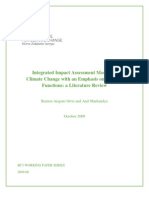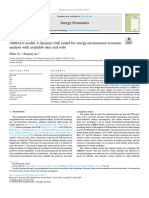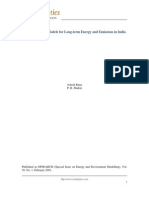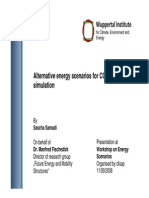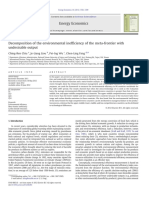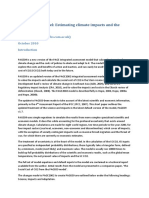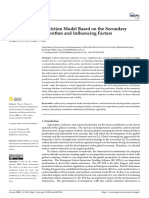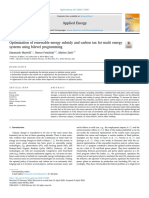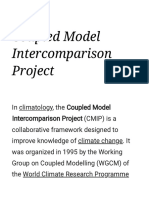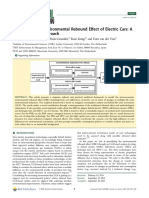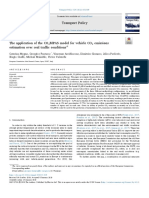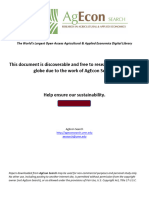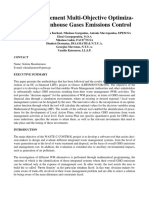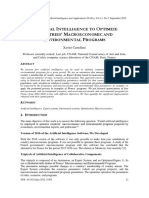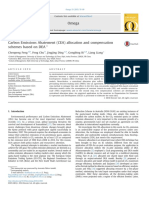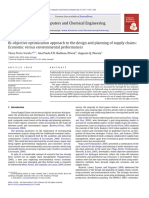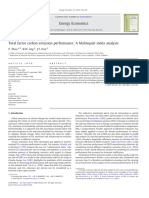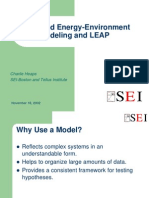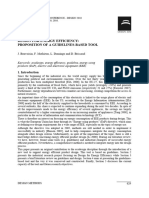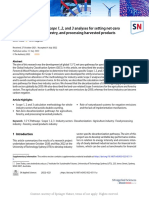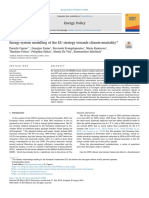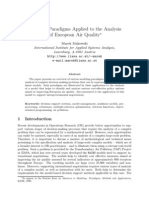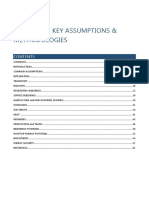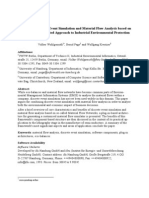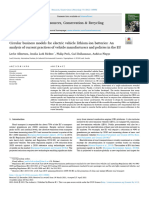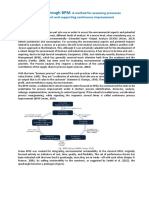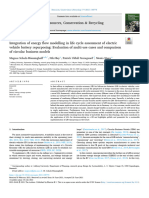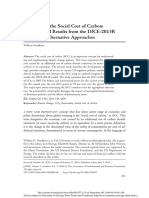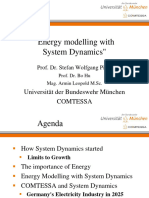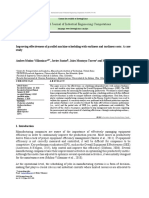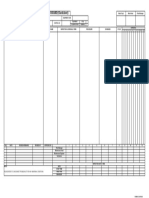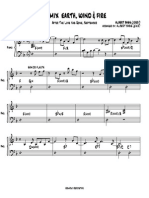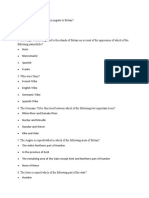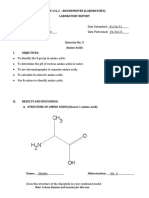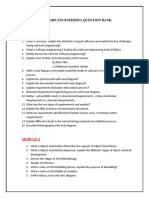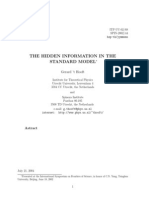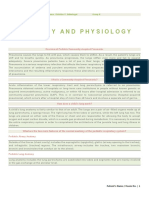Amann Modelintercomparison 2009
Amann Modelintercomparison 2009
Uploaded by
Jose A. SuarezCopyright:
Available Formats
Amann Modelintercomparison 2009
Amann Modelintercomparison 2009
Uploaded by
Jose A. SuarezOriginal Title
Copyright
Available Formats
Share this document
Did you find this document useful?
Is this content inappropriate?
Copyright:
Available Formats
Amann Modelintercomparison 2009
Amann Modelintercomparison 2009
Uploaded by
Jose A. SuarezCopyright:
Available Formats
International Institute for Applied Systems Analysis (IIASA)
Report Part Title: A model intercomparison
Report Title: GHG mitigation potentials in Annex I countries Comparison of model
estimates for 2020
Report Author(s): Markus Amann, Peter Rafaj and Niklas Höhne
International Institute for Applied Systems Analysis (IIASA) (2009)
Stable URL: http://www.jstor.com/stable/resrep15767.4
JSTOR is a not-for-profit service that helps scholars, researchers, and students discover, use, and build upon a wide
range of content in a trusted digital archive. We use information technology and tools to increase productivity and
facilitate new forms of scholarship. For more information about JSTOR, please contact support@jstor.org.
Your use of the JSTOR archive indicates your acceptance of the Terms & Conditions of Use, available at
https://about.jstor.org/terms
International Institute for Applied Systems Analysis (IIASA) is collaborating with JSTOR to
digitize, preserve and extend access to this content.
This content downloaded from
84.125.71.194 on Sat, 10 Aug 2024 10:04:24 UTC
All use subject to https://about.jstor.org/terms
2 A model intercomparison
In March 2009, IIASA invited key modelling teams that have provided estimates of GHG
mitigation potentials and costs to participate in the study and to submit data for the comparison.
A meeting was held at IIASA on May 28-29, 2009 to review the results from different models
and identify factors that explain differences in model estimates.
2.1 Participating models
Eight modelling teams have provided quantitative results to the intercomparison exercise (Table
2.1).
Table 2.1: Participating models
Model Organization Model type Main reference
AIM NIES, Japan Bottom up model Kainuma M. et al., 2007
DNE21+ RITE, Japan Bottom-up model RITE, 2009
GAINS IIASA, Austria Bottom-up model Amann et al., 2008
GTEM Treasury, Australia Computable general Australian Treasury, 2008
equilibrium model
IMAGE PBL, Netherlands Bottom-up integrated MNP, 2006
assessment model
McKinsey McKinsey Bottom-up cost curves McKinsey & Company,
2009
OECD ENV- OECD Computable general OECD, 2009
LINKAGES equilibrium
POLES IPTS Linked bottom-up/top down Russ et al., 2009
2.1.1 AIM (NIES, Japan)
The AIM model, developed by the National Institute for Environmental Studies (NIES), Japan,
comprises three main models - the greenhouse gas emission model (AIM/emission), the global
climate change model (AIM/climate), and the climate change impact model (AIM/impact). The
AIM/emission model estimates greenhouse gas emissions and assesses policy options to reduce
them. The AIM model has several distinct characteristics. It integrates emission, climate and
impact models, contains country modules for detailed evaluations at the national level
and global modules to ensure consistency across individual modules, integrates bottom-
up national modules with top-down global modules, and is designed to assess
alternative policies. AIM contains a very detailed technology selection module to
evaluate the effect of introducing advanced technologies and uses information from a
This content downloaded from
84.125.71.194 on Sat, 10 Aug 2024 10:04:24 UTC
All use subject to https://about.jstor.org/terms
detailed Geographic Information System to evaluate and represent the distribution of
impacts at the local level. More detail is provided in Kainuma M. et al., 2007 and at
http://www-iam.nies.go.jp/aim/infomation.htm.
2.1.2 DNE-21+ (RITE, Japan)
The Dynamic New Earth 21 plus (DNE21+) model has been developed by the Research
Institute of Innovative Technology for the Earth (RITE), Japan. The model covers the entire
world divided over 50 regions. The energy systems model is a bottom-up linear programming
model minimizing world total costs of energy systems. DNE21+ also treats energy-unrelated
CO2 and five kinds of non-CO2 GHG emissions. The non-CO2 GHG model is a proxy model
using elasticities that represent bottom-up assessments of mitigation technologies performed by
USEPA. More information is provided in RITE, 2009.
2.1.3 GAINS (IIASA, Austria)
The Greenhouse gas – Air pollution Interactions and Synergies (GAINS) model has been
developed by the International Institute for Applied Systems Analysis (IIASA), Austria. It uses
a bottom-up approach for quantifying GHG mitigation potentials and costs for the major
Annex I countries, and estimates co-benefits on air pollution. GAINS employs exogenous
activity projections, currently those of the IEA World Energy Outlooks 2007 and 2008 (IEA,
2007, IEA, 2008) . More information is provided in Amann et al., 2008. An interactive version
of GAINS is accessible on the Internet (http://gains.iiasa.ac.at/).
2.1.4 GTEM/MMRF (Australia)
GTEM is a recursively dynamic general equilibrium model developed by the Australian Bureau
of Agricultural and Resource Economics (ABARE) to address policy issues with long-term
global dimensions, such as climate change mitigation costs.
The MMRF model is a detailed model of the Australian economy developed by the Centre of
Policy Studies at Monash University. It is a dynamic model which employs a recursive
mechanism to explain investment and sluggish adjustment in factor markets.
The marginal GHG abatement cost curves for the GTEM and MMRF models are not produced
or derived internally by the models. The information provided by GTEM and MMRF are
abatement curves, which shows the amount of abatement that occurs at the average carbon
price. An abatement curve can differ from a marginal abatement cost curve, due to different
assumptions, environmental targets and emission trajectories.
2.1.5 IMAGE (PBL, Netherlands)
The IMAGE 2.4 Integrated Assessment model (MNP, 2006) (www.mnp.nl/image) consists of a
set of linked and integrated models that together describe important elements of the long-term
dynamics of global environmental change, such as air pollution, climate change, and land-use
change. The global energy model that forms part of this framework, TIMER (van Vuuren et al.,
This content downloaded from
84.125.71.194 on Sat, 10 Aug 2024 10:04:24 UTC
All use subject to https://about.jstor.org/terms
2007), describes the demand and production of primary and secondary energy and the related
emissions of GHGs and regional air pollutants. The FAIR-SiMCaP 2.0 model is a combination
of the abatement costs model of FAIR and the SiMCaP model (den Elzen et al., 2007). The land
and climate modules of IMAGE describe the dynamics of agriculture and natural vegetation,
and, together with input from TIMER and FAIR, resulting climate change.
2.1.6 McKinsey
The global McKinsey GHG abatement cost curve was developed since 2006 and results in this
paper are based on the second version of the global GHG abatement cost curve (McKinsey
2009). The model is mainly based on external baseline sources IEA WEO, US EPA and
Houghton and assesses bottom-up the abatement potential and cost of over 200 abatement levers
in 21 world regions. More information and the online version Climate Desk is accessible on the
Internet (http://solutions.mckinsey.com/climatedesk).
2.1.7 OECD ENV LINKAGES (OECD)
ENV-Linkages is a top-down model (CGE type). This model is still in development, the version
used for the paper is the version 2.1. The ENV-Linkages model is a recursive dynamic neo-
classical general equilibrium model, with a standard time horizon from 2005 to 2050. It is a
global economic model built primarily on a database of national economies.
The model version used for this study represents the world economy in 12 countries/regions,
each with 25 economic sectors (eight energy production sectors), and three representative
agents. Six greenhouse gases are modeled; land use and land cover change emissions are not yet
taken into account. Capital accumulation is modeled as in traditional Solow/Swan neo-classical
growth models.
All production in ENV-Linkages is assumed to operate under cost minimization with an
assumption of perfect markets and the CRS technology. The production technology is specified
as nested CES production functions in a branching hierarchy. Total output for a sector is
actually the sum of two different production streams: resulting from the distinction between
production with an ‘‘old’’ capital vintage, and production with a ‘‘new’’ capital vintage. The
substitution possibilities among factors are assumed to be higher with new capital than with old
capital. International trade flows and prices are fully endogenous and modeled using a
Armington specification. Energy efficiency is partly exogenous, as the autonomous energy
efficiency (AEE) factor is calibrated to match IEA’s projections on energy demand published in
the World Energy Outlook), and partly endogenous with substitution possibility between factors
and goods resulting from prices changes and optimizing behavior of agents. For each year the
government budget is balanced through the income tax, revenues of the carbon tax are then
indirectly rebated to the household, in a lump-sump way since labor supply is exogenous.
2.1.8 POLES (JRC-IPTS, EU)
POLES is a global simulation model of the energy system. The dynamics of the model is based
on a recursive simulation process of energy demand and supply with lagged adjustments to
This content downloaded from
84.125.71.194 on Sat, 10 Aug 2024 10:04:24 UTC
All use subject to https://about.jstor.org/terms
prices and a feedback loop through the international energy price. The model is developed in the
framework of a hierarchical structure of interconnected modules at the international, regional,
and national levels. It contains technologically-detailed modules for energy-intensive sectors,
including power generation, iron and steel, the chemical sector, aluminum production, cement
making, non-ferrous minerals and modal transport sectors (including aviation and maritime
transport). All energy prices are determined endogenously. Oil prices in the long-term depend
primarily on the relative scarcity of oil reserves. The world is broken down into 47 regions, for
which the model delivers detailed energy balances. The model is continuously being enhanced
in both detail and in the degree of regional disaggregation. Recent modifications include the
addition of detailed modules for energy-intensive sectors and an extension to cover non-CO2
greenhouse gases (GHG).
2.2 Data provided for the model intercomparison
As an input for the quantitative model intercomparison, modelling teams provided a set of data
to IIASA that describe sectoral GHG emissions that emerge for a range of carbon prices (i.e.,
for the base year 2005, for the baseline case in 2020, and for 2020 with carbon prices of 0, 20,
50, 100 and >100 US-$/t CO2, respectively.) Such data were delivered for individual Annex I
parties and for Annex I in total.
It is important to note that only the GTEM model provided data for the LULUCF sector.
As not all models cover all countries, not all teams provided a complete set of data:
• AIM: No data have been provided for Canada and Australia.
• IMAGE: Australia and New Zealand have been aggregated into one region, and sectoral
emissions are not included in the provided data. The IMAGE emissions data are not
harmonised with the UNFCCC emissions, and comes directly from the different
IMAGE submodels, which are calibrated for the year 2000. In policy applications with
the IMAGE and FAIR model harmonised data is used.
• OECD: Australia and New Zealand have been aggregated into one region.
• McKinsey: No data have been provided for Australia separately.
• GTEM calculations include LULUCF emissions; for Australia, results of the MMRF
model were provided as well.
• POLES did not provide data for the Australia, New Zealand and Canada. Furthermore,
POLES data do not include emissions from agriculture.
• GAINS and POLES data were recalculated from € to US-$.
This content downloaded from
84.125.71.194 on Sat, 10 Aug 2024 10:04:24 UTC
All use subject to https://about.jstor.org/terms
You might also like
- Build&Grow - Easy Link L5 Workbook Answer KeyDocument15 pagesBuild&Grow - Easy Link L5 Workbook Answer KeyThanh TuanNo ratings yet
- Software Requirements Specification Document: 1.1 PurposeDocument5 pagesSoftware Requirements Specification Document: 1.1 PurposeAnkit YadavNo ratings yet
- NACA Duct TutorialDocument38 pagesNACA Duct Tutorialzebra00100% (1)
- Bourbon The Rise Fall and Rebirth of An American Whiskey Fred MinnickDocument328 pagesBourbon The Rise Fall and Rebirth of An American Whiskey Fred Minnick孙艺博100% (3)
- Special Pathology Solved KMU SEQs by RMC StudentsDocument145 pagesSpecial Pathology Solved KMU SEQs by RMC StudentsAamir Khan0% (1)
- 019 Exercise02-Probability-ANSWERSDocument3 pages019 Exercise02-Probability-ANSWERSNamit100% (1)
- Handbook To The Cathedrals of England-Tom6 PDFDocument286 pagesHandbook To The Cathedrals of England-Tom6 PDFPrivremenko Jedan100% (2)
- Kun SCH 2008Document15 pagesKun SCH 2008Oscar CordobaNo ratings yet
- A Report On IEW 2010Document6 pagesA Report On IEW 2010Mehdi AsaliNo ratings yet
- Energy Planning Policies With Environmental Considerations in NigeriaDocument5 pagesEnergy Planning Policies With Environmental Considerations in NigeriaShakeel RanaNo ratings yet
- Optimization Algorithms For Solving Combined Economic Emission Dispatch: A ReviewDocument6 pagesOptimization Algorithms For Solving Combined Economic Emission Dispatch: A ReviewPurushottam SethyNo ratings yet
- CHAPTER 2-1 Review of LiteratureDocument5 pagesCHAPTER 2-1 Review of LiteratureManoj shettyNo ratings yet
- Integrated Impact Assessment Models of Climate Change With An Emphasis On Damage FunctionsDocument35 pagesIntegrated Impact Assessment Models of Climate Change With An Emphasis On Damage FunctionstrotouslNo ratings yet
- CEEEADocument23 pagesCEEEA377104324zNo ratings yet
- Task 02Document26 pagesTask 02Iftekhar Chowdhury PrinceNo ratings yet
- Macroeconomic Models For Long-Term Energy and Emissions in IndiaDocument34 pagesMacroeconomic Models For Long-Term Energy and Emissions in IndiaNikhil BhargavaNo ratings yet
- Alternative Energy Scenarios For CO Emission Simulation: Sascha SamadiDocument50 pagesAlternative Energy Scenarios For CO Emission Simulation: Sascha Samadisurapong2005No ratings yet
- Energy Economics: Ching-Ren Chiu, Je-Liang Liou, Pei-Ing Wu, Chen-Ling FangDocument8 pagesEnergy Economics: Ching-Ren Chiu, Je-Liang Liou, Pei-Ing Wu, Chen-Ling FangThiago SoaresNo ratings yet
- A EquilibriumDocument25 pagesA EquilibriumDarryl WallaceNo ratings yet
- Energy: Wen-Hsien Tsai, Kuen-Chang Lee, Jau-Yang Liu, Hsiu-Ling Lin, Yu-Wei Chou, Sin-Jin LinDocument9 pagesEnergy: Wen-Hsien Tsai, Kuen-Chang Lee, Jau-Yang Liu, Hsiu-Ling Lin, Yu-Wei Chou, Sin-Jin LinDwi RaraNo ratings yet
- New Version of The PAGDocument6 pagesNew Version of The PAGjuan perez tafurNo ratings yet
- Energies 14 01328 v2Document20 pagesEnergies 14 01328 v2Leon GribanovNo ratings yet
- Combined Life Cycle Assessment and Life Cycle Costing in TheDocument11 pagesCombined Life Cycle Assessment and Life Cycle Costing in ThekadexNo ratings yet
- Ar2013-1231-1241 Tokede Sloan Brown PDFDocument12 pagesAr2013-1231-1241 Tokede Sloan Brown PDFolubukola TokedeNo ratings yet
- Martelli 2020Document13 pagesMartelli 2020saimiracle321No ratings yet
- Coupled Model Intercomparison ProjectDocument27 pagesCoupled Model Intercomparison ProjectAwais chNo ratings yet
- Cost Accounting ResearchDocument18 pagesCost Accounting Researchaa3412712No ratings yet
- The Remarkable Environmental Rebound Effect of Electric Cars A Microeconomic ApproachDocument10 pagesThe Remarkable Environmental Rebound Effect of Electric Cars A Microeconomic ApproachMaruf MuhammadNo ratings yet
- The Application of The CO2MPAS Model For Vehicle CO2 Emissions Estimation Over Real Traffic ConditionsDocument8 pagesThe Application of The CO2MPAS Model For Vehicle CO2 Emissions Estimation Over Real Traffic ConditionsEdwin SilvaNo ratings yet
- Sustainability Accounting GREETDocument13 pagesSustainability Accounting GREETshikhapbanamikaNo ratings yet
- Rebelattoand Frandoloso 2020Document13 pagesRebelattoand Frandoloso 2020mokhtarNo ratings yet
- Using The BIMCO Shipping KPI Database To IdentifyDocument9 pagesUsing The BIMCO Shipping KPI Database To IdentifydevivovincenzoNo ratings yet
- 1 s2.0 S2405880720300194 MainDocument10 pages1 s2.0 S2405880720300194 MainMame Henriette Astou SambouNo ratings yet
- This Document Is Discoverable and Free To Researchers Across The Globe Due To The Work of Agecon SearchDocument25 pagesThis Document Is Discoverable and Free To Researchers Across The Globe Due To The Work of Agecon Searchk60.2114113008No ratings yet
- Waste Management Multi-Objective Optimiza-Tion For Greenhouse Gases Emissions ControlDocument11 pagesWaste Management Multi-Objective Optimiza-Tion For Greenhouse Gases Emissions ControlMario WhoeverNo ratings yet
- Decarbonization Options in The Russian Energy SectDocument11 pagesDecarbonization Options in The Russian Energy Sectasmaa.lalaouirhali19No ratings yet
- International Journal of Project ManagementDocument34 pagesInternational Journal of Project Managementpradnya_nagotkarNo ratings yet
- Artificial Intelligence To Optimize Countries' Macroeconomic and Environmental ProgramsDocument21 pagesArtificial Intelligence To Optimize Countries' Macroeconomic and Environmental ProgramsAdam HansenNo ratings yet
- 2015 OMEGA 正式版Document12 pages2015 OMEGA 正式版Chenpeng FENGNo ratings yet
- Bi-Objective Optimization Approach To The Design and Planning of Supply ChainsDocument15 pagesBi-Objective Optimization Approach To The Design and Planning of Supply Chainsj3qbzodj7No ratings yet
- 1 s2.0 S0140988309001868 MainDocument8 pages1 s2.0 S0140988309001868 MainDebelo DiyanaNo ratings yet
- Integrated Energy-Environment Modeling and LEAP: Charlie Heaps SEI-Boston and Tellus InstituteDocument44 pagesIntegrated Energy-Environment Modeling and LEAP: Charlie Heaps SEI-Boston and Tellus InstituteIvo Silva AraújoNo ratings yet
- 1 s2.0 S2211467X22000955 MainDocument13 pages1 s2.0 S2211467X22000955 Mainjun luNo ratings yet
- EE Guideline ToolDocument10 pagesEE Guideline TooljemmadNo ratings yet
- A Comprehensive Review of Full Cost Accounting MetDocument42 pagesA Comprehensive Review of Full Cost Accounting Metajaygupta.af3919No ratings yet
- RVI111Roson enDocument13 pagesRVI111Roson enyelida blancoNo ratings yet
- International Journal of Project ManagementDocument34 pagesInternational Journal of Project ManagementIoan BacaNo ratings yet
- Global Sector-Specific Scope 1 2 and 3 Analyses FoDocument20 pagesGlobal Sector-Specific Scope 1 2 and 3 Analyses FoEmel ÇakarNo ratings yet
- Energy-System Modelling of The EU Strategy Towards Climate-NeutralityDocument15 pagesEnergy-System Modelling of The EU Strategy Towards Climate-NeutralitypcaprosNo ratings yet
- Modeling Paradigms Applied To The Analysis of European Air QualityDocument28 pagesModeling Paradigms Applied To The Analysis of European Air QualityDong HungNo ratings yet
- Appliance Energy Policy Tools 2012Document27 pagesAppliance Energy Policy Tools 2012Desiyantri Siti PinundiNo ratings yet
- Environmental/economic Power Dispatch Using A Fuzzified Multi-Objective Particle Swarm Optimization AlgorithmDocument11 pagesEnvironmental/economic Power Dispatch Using A Fuzzified Multi-Objective Particle Swarm Optimization AlgorithmSivasubramani ShanmugaveluNo ratings yet
- APEC Energy Outlook MethodologyDocument67 pagesAPEC Energy Outlook MethodologyAlex Isidro Suxso HanccoNo ratings yet
- MainDocument24 pagesMainssfofoNo ratings yet
- Circular Business Models For Electric Vehicle Lithium-Ion BatteriesDocument15 pagesCircular Business Models For Electric Vehicle Lithium-Ion BatteriesadriiiiiNo ratings yet
- E-Note 735 Content Document 20220606120229PMDocument4 pagesE-Note 735 Content Document 20220606120229PMJaswanth NaiduNo ratings yet
- Guevara 2017Document21 pagesGuevara 2017mahatma streetNo ratings yet
- Battery Repurposing Blog Source 2Document12 pagesBattery Repurposing Blog Source 2karthikNo ratings yet
- Estimates of The Social Cost of Carbon: Concepts and Results From The DICE-2013R Model and Alternative ApproachesDocument40 pagesEstimates of The Social Cost of Carbon: Concepts and Results From The DICE-2013R Model and Alternative ApproachesIbal LaodeNo ratings yet
- EMA ImplementationDocument11 pagesEMA ImplementationwyayiNo ratings yet
- Traffic Road Emission Estimation Through Visual Programming Algorithms and Building Information Models: A Case StudyDocument28 pagesTraffic Road Emission Estimation Through Visual Programming Algorithms and Building Information Models: A Case StudyyecidaNo ratings yet
- Pickl Oegor2013Document70 pagesPickl Oegor2013tuyulidr00005No ratings yet
- 2019Document18 pages2019crazy JNo ratings yet
- Evaluating Opportunities To Improve Material and Energy Impacts in Commodity Supply ChainsDocument7 pagesEvaluating Opportunities To Improve Material and Energy Impacts in Commodity Supply Chainsmohammadmehrabi9640No ratings yet
- EIB Working Papers 2019/02 - How energy audits promote SMEs' energy efficiency investmentFrom EverandEIB Working Papers 2019/02 - How energy audits promote SMEs' energy efficiency investmentNo ratings yet
- G7-Q1 Week 3Document3 pagesG7-Q1 Week 3Alvin SevillaNo ratings yet
- TÀI LIỆU TẮC KÊ NHỰA FISCHER - FIS SXDocument3 pagesTÀI LIỆU TẮC KÊ NHỰA FISCHER - FIS SXAB CBNo ratings yet
- Cleaning, Inspection, Lubrication & Overhauling ChecksheetDocument1 pageCleaning, Inspection, Lubrication & Overhauling ChecksheetAlleo MarquezNo ratings yet
- Organizational Behaviour Assingment On Iqbal Movie ReviewDocument5 pagesOrganizational Behaviour Assingment On Iqbal Movie ReviewSaraswati ChoudharyNo ratings yet
- C Basic ConceptDocument10 pagesC Basic ConceptShovan KarmakarNo ratings yet
- EntrepBusiness Plan PartVVISAMPLEDocument2 pagesEntrepBusiness Plan PartVVISAMPLEleii xxuNo ratings yet
- Maths Test CareerDocument86 pagesMaths Test CareerVinayak K HardekarNo ratings yet
- IPAL Fish ProcessingDocument1 pageIPAL Fish ProcessingSaktiSiregar99No ratings yet
- CV Format For PakistanDocument4 pagesCV Format For PakistanUzair ShahidNo ratings yet
- 10-Mix Earth Wind & Fire - PianoDocument11 pages10-Mix Earth Wind & Fire - PianoJuan M. Perez100% (1)
- Astm C128Document23 pagesAstm C128LC LeeNo ratings yet
- Anglo Saxon LiteratureDocument32 pagesAnglo Saxon LiteratureAzad RahmanNo ratings yet
- Writeup For Engineering Lab ExperimentsDocument16 pagesWriteup For Engineering Lab ExperimentsrobinbohareNo ratings yet
- Laboratory Outline - Exercise 5Document6 pagesLaboratory Outline - Exercise 5Majestic RavenNo ratings yet
- SE Question BankDocument3 pagesSE Question BankninaNo ratings yet
- Hidden Information in The Standard ModelDocument11 pagesHidden Information in The Standard Modelaud_philNo ratings yet
- Tarif RSCA Medan Apr 2022Document53 pagesTarif RSCA Medan Apr 2022ratna ninaNo ratings yet
- Engineering Systems Dynamics Modelling Simulation and Design 1634844603Document267 pagesEngineering Systems Dynamics Modelling Simulation and Design 1634844603kaiser777100% (1)
- Case 3 - Anatomy and Physiology - SalimbagatDocument4 pagesCase 3 - Anatomy and Physiology - SalimbagatChristine Pialan SalimbagatNo ratings yet
- 7.1 Parabolas Worksheet and AnswersDocument4 pages7.1 Parabolas Worksheet and AnswersAnthony WangNo ratings yet
- Pierre Frankel in Moscow (A) : Unfreezing Change: Problem DefinitionDocument2 pagesPierre Frankel in Moscow (A) : Unfreezing Change: Problem DefinitionAJINKYA AMBIKENo ratings yet
- Chapter 4Document34 pagesChapter 4Hameed GulNo ratings yet
- Resume Morikubo JennaDocument1 pageResume Morikubo Jennaapi-272789310No ratings yet












